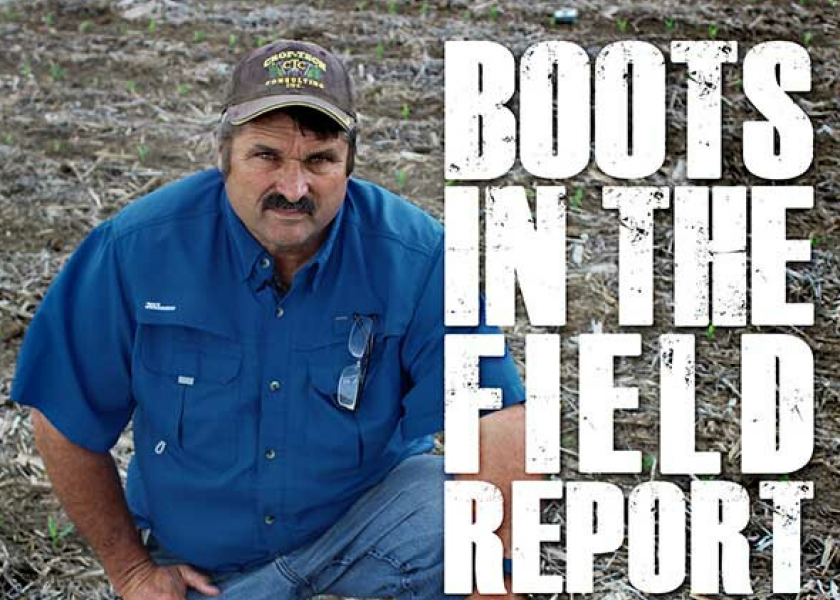Ferrie: Assess Your Risks for Tar Spot this Season

Tar spot decimated many central Illinois cornfields in 2021. But the disease was nearly a no-show in those same fields this past year. One farmer recently asked Ken Ferrie, “What kind of risk do we have in 2023?”
It’s a question that Ferrie, Farm Journal Field Agronomist, has asked himself repeatedly in the past few months. Here are some of his answers, which he hopes will help farmers this coming season who are equally concerned about their risk to tar spot.
“These are my personal observations, and I reserve the right to change them as we learn more about tar spot,” he adds.
Keep in mind those fields of corn affected in 2021 will be back in corn in 2023, if you’re in a corn-soybean rotation.
Any fields with higher residue are going to be more susceptible to tar spot due to the fact that the inoculant is in that residue from the 2021 crop. This would include fields in strip till, no-till and vertical till – fields in any cultural practice that leaves more corn residue at the surface from the past crop are likely more at risk.
“In 2021 we saw tar spot early on the corn-on-corn crops first,” he recalls. “But once it fired up, it was everywhere. Spore clouds infected a lot of fields in a hurry.”
In these fields, for 2023, one of the major threats comes in the form of what Ferrie calls homegrown tar spot infections.
“Because it takes microbes about four years to completely digest a corn stalk, most likely there's tar spot inoculant in about every field that was infected in 2021,” he contends. “I would not expect tillage or crop rotation to do much to relieve the potential pressure for this year.”
Ferrie’s agronomic sleuthing also indicates that heavy rain events play a more significant role in homegrown infections than previously realized or understood.
“While we need climate conditions to drive the startup of such infections, we also need one of those hard-driving rains to splash inoculant up on the plant,” he says.
“As we continue to study this beast, I think we’ll see such rains play a bigger role in firing up homegrown tar spot – the stuff that starts at the bottom of the plant – than even the other moist conditions throughout the season,” he adds. “I believe a heavy, splashing rain event is more important than seven hours of leaf wetness.”
Ferrie decided to test his hypothesis about hard rain events at his agronomic campus, Crop-Tech Inc., Heyworth, Ill. in 2022.
He planted a susceptible hybrid into a no-till, corn-on-corn plot that was devastated in 2021 by tar spot. He then set up sprinklers to water the corn early morning and late evening to achieve seven hours of leaf wetness.
“I never worked so hard to get a disease I didn't want,” Ferrie says, with a wry chuckle. “But in the end, tar spot did not infect the susceptible hybrid.”
With no big rains to splash the inoculant up onto the corn plants, it didn't reach a threshold level.
“The conditions weren't in favor of tar spot last summer (in central Illinois), as we kind of had a flash of drought through here between June and July,” he reports.
Ferrie’s team added a sprinkler system to the plot to increase moisture levels. But even that wasn't enough to trigger a tar spot outbreak.
Ferrie says he believes irrigation supports development of tar spot, but that a hard-driving rain that splashes inoculant up onto the plant is of equal or greater concern.
“This type of rain most likely is going to be the most effective in spreading the disease if it happens right before rows close (canopy),” he says.
His hypothesis is the inoculant gets onto the plants, then the rows close, helping to keep the infection in the crop, and it builds from there.
“Once that homegrown tar spot gets fired up, then it can lead to the windblown tar spot that moves and reproduces much faster and doesn't need a hard-driving rain to keep it moving,” Ferrie contends.
Looking back, Ferrie says northeast Iowa, southern Minnesota and parts of central Wisconsin saw their first tar spot outbreaks late in September of 2021. But they occurred too late to do much crop damage.
That wasn’t the case in 2022.
“Some of those areas did receive heavy rain events this past spring triggering the homegrown infection of tar spot by mid- to late August, which produced windblown spores that infected a lot of fields, no matter what the crop rotation was,” Ferrie recalls. “Tar spot dinged yields up there 30 to 50 bushels in some fields.”
Ferrie says one significant question for farmers to answer now: is tar spot in your neighborhood?
“I'm not asking whether tar spot hurt your yields last year. I'm saying, is it in your neighborhood? Did it show up a year ago? Or did it show up in 2022 too late to do any damage?” he says.
“I think we must play defense and watch the weather conditions, scout and be ready to make one or more fungicide applications. Maybe you plant a hybrid that can handle the tar spot better.”
Ferrie adds that if you've been seriously scouting the past couple of years and haven't seen tar spot yet, he believes your risk of homegrown tar spot is lower, and your main threat from the disease would be from windblown spores coming in from other areas.
To learn more about Ferrie's perspective on tar spot risks for 2023, listen to this week's Boots In The Field podcast here:







